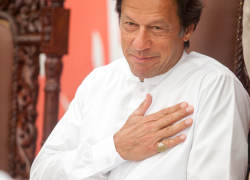Why the financial crisis is getting worse in the universities in Pakistan?
Higher education institutes in Pakistan are walking a financial tightrope, these days. As reported by an esteemed English daily, as many as 15 public sectors universities of Khyber Pakhtunkhwa are facing severe financial crisis. This state of affairs has generated serious apprehension in the public sector universities, during the last couple of years. The issue has been raised through mass media. The academic leaders, university administrators and research scholars talked a lot about it. Nonetheless, the issue failed to grab the attention of the people at the helm of affairs.
This blog post is aimed at spotlighting three important issues. The public sector universities across the length and breadth of Khyber Pakhtunkhwa are under financial strain. This situation is incomparable in its degree and genesis and finds no parallel in the history of higher education in the country. This situation is getting from bad to worse. More importantly, it is the policies of the successive democratically elected governments which perpetuated financial crisis in the public sector universities.
Introduction
In fact, the higher education systems in Pakistan is under enormous pecuniary strain, these days. The campuses, in general, are chronically underfunded. Financial dependence on the state means that funding levels fluctuate with the ups and downs of government resources. And this is happening every now and then. The academics, across the board, are profoundly concerned about their ever-increasing financial constraints which hindered their ability to optimally perform and deliver.
Background
The government has stifled runoff funds to the public sector universities for the last couple of months. All schemes, concerning overseas scholars and scholarships, have been adversely affected. The hiring of new faculty, capacity building of the existing staff and arranging workshops and seminars, which are the core features of the university academic life, have been seriously affected as funding for such activities has been substantially constrained.
Some of the universities are on the brink of closure, others are unable to pay salaries to the employees and some did not have sufficient money to pay utility bills. The situation deteriorated to the extent that some of the universities have started thinking in terms of closing some programs, till the situation improves.
In fact, public sector universities continued to suffer for the lack of serious attention of the successive governments. The higher education institutions remained largely incapable of serving the country’s needs to meet the challenges of globalization, economic development and technological advancement, not to mention the challenges of digital Pakistan. Financial resources required for the reform initiatives, to be put in place, were generally not available. Pakistan’s inability to increase investment in education beyond 2.5 per cent of GNP (one of the lowest in the world) signified this sad neglect.
Looking at the historical background of the financial troubles in the university in Pakistan while examining the data for the last 20 years, it is revealed that ironically universities, came under pressures more during the incumbency of the democratically elected governments.
Financial health of the universities under military rule
During the Musharraf regime, the universities had not encountered any such problem. Throughout the period, more than sufficient funds were available at the disposal of the higher education and research institutes. At times, certain universities were disbursed money in excess of their actual requirement. Dr Atta-ur Reman was in the vanguard of the entire reform movement.
To begin with, drastic and far-reaching changes were brought about in the higher education landscape with the establishment of the HEC. The budget for higher education was increased from only Rs.500 million in the year 2000 to Rs.28 billion in 2008. The student enrolment in the universities increased from 270,000 to 900,000 and the number of universities and degree awarding institutes increased from 57 in the year 2000 to 137 by the year 2008.
This was a golden era in the history of higher education in Pakistan marked mainly by generous funding to the universities with prime focus on capacity building and human resource development. The available faculty in the universities was strengthened through the faculty development program. Some 3,000 scholars were sent abroad for higher studies, whereas, some 4,000 were enrolled in the doctoral program under the Indigenous Fellowship Scheme. Foreign faculty was lured on hefty emoluments. Handsome pay packages were offered to the faculty with the aim to allow the university teachers to enjoy the freedom of teaching and research having financial independence.
Nevertheless, when these reforms were about to bear fruit in the desired fashion; it seemed that all of a sudden, the curtain was fallen and the universities startlingly found themselves in deep troubles.
Financial health of the universities under civilian government
The universities started feeling financial troubles, for the first time, with the advent of the democratically elected government in 2008. Within no time, releases to the public sector universities were constrained or stopped altogether. Almost all public-sector universities in the country started facing a stiff financial crunch, subsequent to the Finance Ministry’s refusal to release the Higher Education Commission of Pakistan’s developmental and recurring grant of over 8 billion rupees, for the year 2007-08, which were due by April 2008. This rendered all public sector universities virtually cash strapped. Since then, the universities, every now and then, have been confronting grievous financial problems.
The financial crises further deepened, very recently, when the newly democratically elected government of PTI assumed the office. It was reported earlier that only three universities in Khyber Pakhtunkhwa (i.e., University of Peshawar, Gomal University, D.I. Khan and University of Agriculture, Peshawar) were facing crunch, nonetheless, it has recently been reported that almost all public sector universities with few exceptions are having financial difficulties. The 02 universities in the province having no shortfall or deficit include Khyber Medical University Peshawar and Kohat University of Science and Technology. Both have sufficient funds available with them.
Conclusion
This blog post made three important points. One, the universities across the length and breadth of Khyber Paktunkhawa suffered a great deal, on account of recent budgetary constraints. Second, the financial problems of the universities are getting unmanageable with each passing day with no respite in sight. Last but not least, it was the civilian administration under which the universities experienced financial difficulties more than the military regime. With the current state of affairs being considered as transitory, it is said that the government is trying to resolve the issue and soon the situation will get better.


















